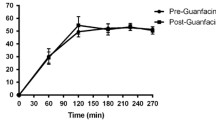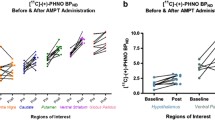Abstract
Rationale
The cardiovascular effects of psychostimulant drugs (methylphenidate, amphetamine, cocaine) have been mostly associated with their noradrenergic effects. However, there is some evidence that dopaminergic effects are involved in the cardiovascular actions of these drugs. Here, we evaluated this association in humans.
Methods
Positron emission tomography (PET) and [11C]raclopride, a dopamine (DA) D2 receptor radioligand that competes with endogenous DA for occupancy of the D2 receptors, were used to measure changes in brain DA after different doses of intravenous methylphenidate in 14 healthy subjects. Cardiovascular (heart rate and blood pressure) and catecholamine (plasma epinephrine and norepineprhine) responses were determined in parallel to assess their relationships to methylphenidate-induced changes in brain DA.
Results
Methylphenidate administration significantly increased heart rate, systolic and diastolic blood pressures and epinephrine concentration in plasma. The increases in blood pressure were significantly correlated with methylphenidate-induced increases of DA in striatum (r>0.78, P<0.001) and of plasma epinephrine levels (r>0.82, P<0.0005). In turn methylphenidate-induced DA increases in striatum were correlated with increases of epinephrine in plasma (r=0.85, P<0.0001). Subjects in whom methylphenidate did not increase DA had no change in blood pressure or in plasma epinephrine concentration.
Discussion
These results are consistent with the hypothesis that methylphenidate-induced increases in blood pressure are in part due to its central dopaminergic effects. They also suggest that methylphenidate's pressor effects may be in part mediated by DA-induced increases in peripheral epinephrine.



Similar content being viewed by others
References
Angrist B, Lee HK, Gershon S (1974) The antagonism of amphetamine-induced symptomatology by a neuroleptic. Am J Psychiatry 131:817–819
Angrist B, Sanfilipo M, Wolkin A (2001) Cardiovascular effects of 0.5 milligrams per kilogram oral d-amphetamine and possible attenuation by haloperidol. Clin Neuropharmacol 24:139–144
Ballard JE, Boileau RA, Sleator EK, Massey BH, Sprague RL (1976) Cardiovascular responses of hyperactive children to methylphenidate. JAMA 236:2870–2874
Breier A, Su TP, Saunders R, Carson RE, Kolachana BS, de Bartolomeis A, Weinberger DR, Weisenfeld N, Malhotra AK, Eckelman WC, Pickar D (1997) Schizophrenia is associated with elevated amphetamine-induced synaptic dopamine concentrations: evidence from a novel positron emission tomography method. Proc Natl Acad Sci USA 94:2569–2574
Brown RT, Wynne ME, Slimmer LW (1984) Attention deficit disorder and the effect of methylphenidate on attention, behavioral, and cardiovascular functioning. J Clin Psychiatry 45:473–476
Chiarello RJ, Cole JO (1987) The use of psychostimulants in general psychiatry. A reconsideration. Arch Gen Psychiatry 44:266–295
Cornish JL, Wilks DP, Van den Buuse M (1997) A functional interaction between the mesolimbic dopamine system and vasopressin release in the regulation of blood pressure in conscious rats. Neuroscience 81:69–78
Dewey SL, Smith GS, Logan J, Brodie JD, Fowler JS, Wolf AP (1993) Striatal binding of the PET ligand 11C-raclopride is altered by drugs that modify synaptic dopamine levels. Synapse 13:350–356
Findling RL, Short EJ, Manos MJ (2001) Short-term cardiovascular effects of methylphenidate and adderall. J Am Acad Child Adolesc Psychiatry 40:525–529
Ganong WF (2001) Review of medical physiology, 12th edn. McGraw-Hill, New York
Greenhill LL, Pliszka S, Dulcan MK, Bernet W, Arnold V, Beitchman J, Benson RS, Bukstein O, Kinlan J, McClellan J, Rue D, Shaw JA, Stock S (2002) American academy of child and adolescent psychiatry. Practice parameter for the use of stimulant medications in the treatment of children, adolescents, and adults. J Am Acad Child Adolesc Psychiatry 41:26S–49S
Joyce PR, Nicholls MG, Donald RA (1984) Methylphenidate increases heart rate, blood pressure and plasma epinephrine in normal subjects. Life Sci 34:1707–1711
Kaufman MW, Cassem NH, Murray GB, Jenike M (1984) Use of psychostimulants in medically ill patients with neurological disease and major depression. Can J Psychiatry 29:46–49
Kirk RE (1990) Statistics: an introduction. Holt, Rinehart, and Winston, Fort Worth
Klein-Schwartz W (2002) Abuse and toxicity of methylphenidate. Curr Opin Pediatr 14:219–223
Kuczenski R, Segal DS (1997) Effects of methylphenidate on extracellular dopamine, serotonin, and norepinephrine: comparison with amphetamine. Neurochemistry 68:2032–2037
Kujacic M, Hansson LO, Carlsson A (1995) Acute dopaminergic influence on plasma adrenaline levels in the rat. Eur J Pharmacol 273:247–257
Laruelle M (2000) Imaging synaptic neurotransmission with in vivo binding competition techniques: a critical review. J Cereb Blood Flow Metab 20:423–451
Le Moal M, Simon H (1991) Mesocorticolimbic dopaminergic network: functional and regulatory roles. Physiol Rev 71:155–234
Littner M, Johnson SF, McCall WV, Anderson WM, Davila D, Hartse SK, Kushida CA, Wise MS, Hirshkowitz M, Woodson BT (2001) Standards of practice committee. Practice parameters for the treatment of narcolepsy: an update for 2000. Sleep 24:451–466
Logan J, Fowler JS, Volkow ND, Wolf AP, Dewey SL, Schlyer D, MacGregor RR, Hitzemann R, Bendriem B, Gatley SJ, Christman DR (1990) Graphical analysis of reversible radioligand binding from time-activity measurements applied to [N-11C-methyl]-(1)-cocaine PET studies in human subjects. J Cereb Blood Flow Metab 10:740-747
Logan J, Volkow ND, Fowler JS, Wang G-J, Dewey SL, MacGregor R, Schlyer D, Gatley SJ, Pappas N, King P, Hitzemann R, Vitkun S (1994) Effects of blood flow on [11C] raclopride binding in the brain: model simulations and kinetic analysis of PET data. J Cereb Blood Flow Metab 14:995–1010
Mannelli M, Lazzeri C, Ianni L, La Villa G, Pupilli C, Bellini F, Serio M, Franchi F (1997) Dopamine and sympathoadrenal activity in man. Clin Exp Hypertens 19:163–179
Parran TV, Jasinski DR (1991) Intravenous methylphenidate abuse: prototype for prescription drug abuse. Arch Intern Med 151:781–783
Rozans M, Dreisbach A, Lertora JJ, Kahn MJ (2002) Palliative uses of methylphenidate in patients with cancer: a review. J Clin Oncol 20:335–339
Rush CR, Baker RW (2001) Behavioral pharmacological similarities betwen methylphenidate and cocaine in cocaine abusers. Exp Clin Psychopharmacol 9:59–73
Schindler CW, Gilman JP, Bergman J, Mello NK, Woosley RL, Goldberg SR (2002) Interactions between cocaine and dopamine agonists on cardiovascular function in squirrel monkeys. J Pharmacol Exp Ther 300:180–187
Seeman P, Guan HC, Niznik HB (1989) Endogenous dopamine lowers the dopamine D2 receptor density as measured by 3H raclopride: implications for positron emission tomography of the human brain. Synapse 3:96–97
Srinivas NR, Hubbard JW, Quinn D, Korchinski ED, Midha K (1991) Extensive and enantioselective presystemic metabolism of dl-threo-methylphenidate in humans. Prog Neuropsychopharmacol Biol Psychiatry15:213–220
Stowe CD, Gardner SF, Gist CC, Schulz EG, Wells TG (2002) 24-hour ambulatory blood pressure monitoring in male children receiving stimulant therapy. Ann Pharmacother 36:1142–1149
Swanson JM, Cantwell D, Lerner M, McBurnett K, Hanna G (1991) Effects of stimulant medication on learning in children with ADHD. J Learn Disabil 24:219–230
Tella SR (1996) Possible novel pharmacodynamic action of cocaine: cardiovascular and behavioral evidence. Pharmacol Biochem Behav 54:343–354
Tella SR, Goldberg SR (1998) Monoamine transporter and sodium channel mechanisms in the rapid pressor response to cocaine. Pharmacol Biochem Behav 59:305–312
van den Buuse M (1997) Pressor responses to brain dopaminergic stimulation. Clin Exp Pharmacol Physiol 24:764–769
van den Buuse M (1998) Role of the mesolimbic dopamine system in cardiovascular homeostasis. Stimulation of the ventral tegmental area modulates the effect of vasopressin on blood pressure in conscious rats. Clin Exp Pharmacol Physiol 25:661–668
van den Buuse M, Catanzariti R (2000) Stimulation of the ventral tegmental area enhances the effect of vasopressin on blood pressure in conscious rats. Br J Pharmacol 129:29–36
Volkow ND, Fowler JS, Wang G-J, Dewey SL, Schlyer D, MacGregor R, Logan J, Alexoff D, Shea C, Hitzemann R, Angrist B, Wolf AP (1993) Reproducibility of repeated measures of 11C raclopride binding in the human brain. J Nucl Med 34:609–613
Volkow ND, Wang G-J, Fowler JS, Logan J, Schlyer D, Hitzemann R, Lieberman J, Angrist B, Pappas N, Mac Gregor R, Burr G, Cooper T, Wolf AP (1994) Imaging endogenous dopamine competition with [11C]raclopride in the human brain. Synapse 16:255–262
Volkow ND, Ding Y-S, Fowler JS, Wang GJ, Logan J, Gatley SJ, Dewey SL, Ashby C, Lieberman J, Hitzemann R, Wolf AP (1995) Is methylphenidate like cocaine? Studies on their pharmacokinetics and distribution in human brain. Arch Gen Psychiatry 52:456–463
Volkow ND, Wang G-J, Fowler JS, Logan J, Gatley SJ, Wong C, Hitzemann RJ, Pappas N (1999) Reinforcing effects of psychostimulants in humans are associated with increases in brain dopamine and occupancy of D2 receptors. J Pharmacol Exp Ther 291:409–415
Wang G-J, Volkow ND, Fowler JS, Logan J, Pappas NR, Natusil N, Wong CT, Hitzemann RJ (1999) Reproducibility of repeated measures of endogenous dopamine competition with [C-11]raclopride in the human brain. J Nucl Med 40:1285–1291
Wilens TE, Spencer TJ, Biederman J (2002) A review of the pharmacotherapy of adults with attention-deficit/hyperactivity disorder. J Atten Disord 5:189–202
Acknowledgements
This research was supported in part by the U.S. Department of Energy under contract DE-ACO2–76CH00016 and NIDA grants DA09490 and DA06278. We wish to thank David Schlyer, for Cyclotron operations; Donald Warner for PET operations; Colleen Shea, Robert MacGregor, Victor Garza, Richard Ferrieri and Payton King for radiotracer preparation and analysis; Thomas P Cooper for methylphenidate plasma analysis and Noelwah Netusil and Pauline Carter for patient care.
Author information
Authors and Affiliations
Corresponding author
Rights and permissions
About this article
Cite this article
Volkow, N.D., Wang, GJ., Fowler, J.S. et al. Cardiovascular effects of methylphenidate in humans are associated with increases of dopamine in brain and of epinephrine in plasma. Psychopharmacology 166, 264–270 (2003). https://doi.org/10.1007/s00213-002-1340-7
Received:
Accepted:
Published:
Issue Date:
DOI: https://doi.org/10.1007/s00213-002-1340-7




